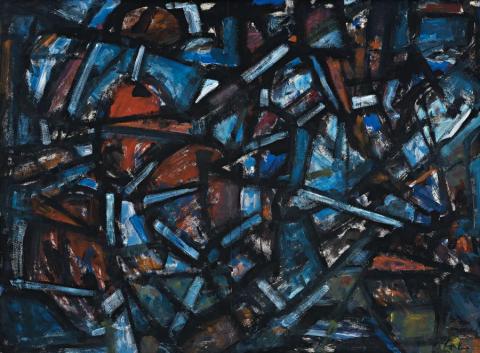EXPERIENCE, c.1964-66
ROGER KEMP
synthetic polymer paint on paper on composition board
108.0 x 147.0 cm
signed lower right: Roger Kemp
Leonard Joel, Melbourne, 2 November 1988, lot 1302
Wesfarmers Art Collection, Perth (label attached verso)
The Song of the Lamb: The Wesfarmers Collection of Australian Art, Art Gallery of Western Australia, Perth, 19 August – 2 October 1989
Gooding, J., Topliss, H., Sharkey, C., and Horridge, N., The Song of the Lamb: The Wesfarmers Collection of Australian Art, Art Gallery of Western Australia, Perth, 1989, p. 100 (illus.)
Roger Kemp's Experience was painted during the mid-sixties as his work was moving towards new heights through the breadth and freedom of his technique. The orchestration of rich reds and blues bounded by blacks, as in stained glass windows, is full of restless energy. Nevertheless, the ceaseless motion of the imagery is held in the paradox of contemplation, of stillness glowing with light. It is as if the universe's infinity of movement, explored in vibrant, colourful imagery, has been frozen in a flicker of time. It brings to mind lines from William Blake's Auguries of Innocence:
To see a world in a grain of sand,
And a heaven in a wild flower,
Hold infinity in the palm of your hand,
And eternity in an hour.
Kemp's work is full of meaningful paradoxes. One shade of meaning reflects another, or, as in experience, as an event affects one. From involvement grows knowledge. Kemp uses abstraction as the pathway to that which resides beyond the common place of reason, where intuition leads to experience of the spiritual - that which is beyond the material - but within the grasp of all who endeavour. Masterly use of pictorial space is part of Kemp's means and genius. In Experience a vortex draws the viewer into itself while in plentiful dialogue with the active surface plane. As stained glass was once used in churches to teach the Bible stories to those who could not read, so do Kemp's paintings provide their own illuminations with a visual resonance that is extraordinary. His brush does not paint the visible world, rather the metaphysical. In 1971 Kemp said, 'We are moving into a new space area. There is nothing there and you have to establish something.'1 In his perceptive study of Kemp, Hendrik Kolenberg observed, 'His was a cosmic, philosophical vision, man as part of an infinitely varied universe. His visual language, his vision, is perhaps closest to those of twentieth-century science - the study of space and time, or life as seen under a microscope.'2 The rhythmic succession of shapes and lines in Experience, Revolving Forms c1960-65 (Art Gallery of New South Wales, Sydney), and other similar paintings, acts as a visual mantra. The by-product of this aid to concentration is sound, reminding us of the deeply felt musical qualities of Kemp's art. Here, the sonorous tones of the organ harmonise with the colour light of stained glass in a deeply moving painting. Of many such others, the grand Chorale 1975-76 in the collection of the Art Gallery of Western Australia, Perth is particularly memorable. Others breathe serenity.
1. Roger Kemp, transcript of a tape-recording by Roger Lockwood, Morning Peninsula in 1971, quoted in Kolenberg, K., Roger Kemp: the complete etchings, Art Gallery of New South Wales, Sydney, 1991, p. 8
2. Ibid, p. 13
DAVID THOMAS
